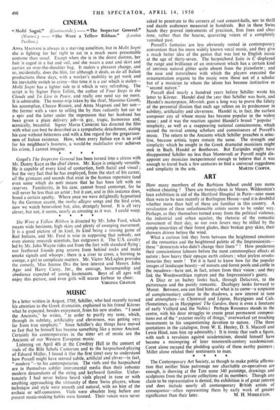ART How many members of the Barbizon School could you
name without cheating ? There are twenty-three in Messrs. Wildenstein's loan exhibition in aid of the Hertford Hospital in Paris—nine more than were to be seen recently at Burlington House—and it is doubtful whether more than half of these are familiar in this country. A revaluation of these unfashionable artists seems to be under way. Perhaps, as they themselves turned away from the political violence, the industrial and urban squalor, the rhetoric of the romantic movement of their day, so our own fevers may be stilled by the simple sincerities of their forest glades, their broken grey skies, their showers driven before the wind.
What a curious link they form between the heightened emotions of the romantics and the heightened palette of the Impressionists— these " democrats who didn't change their linen " ! How ponderous their conscientious labours before the most commonplace effects of nature ; how heavy their opaque earth colours ; what joyless revolu- tionaries they seem ! Yet it is hard to know how far the popular images of landscape beauty—of sunsets and forest pools and cattle in the meadows—have not, in fact, arisen from their vision ; and they link the Wordsworthian rapture and the Impressionist's gaiety.
A Diaz or an Isabey looks back, through Delacroix, to the picturesque and the purely romantic. Daubigny looks forward to Monet. Between, one can find hints of what is to come—a suspicion of complementary colour in the shadows, a new interest in tone and atmosphere—in Chintreuil and Lepine, Harpignies and Cals. (Sometimes, as in Harpignies' The Garden, there is even a foretaste of early Vuillard and the Nabis.) Perhaps Rousseau stands in the centre, with his dour struggles to create great permanent composi- tions out of the " exterior reality of things," overworked yet touching monuments to his unquestioning devotion to nature. (The three quotations in the catalogue, from W. E. Henley, D. S. Maccoll and Lewis Hind, sum him up admirably.) It is ironic that such a figure, with such a revulsion against academicism, should himself have become a mainspring of later nineteenth-century academicism. Corot alone escaped the plodding quality of these earthy painters ; Millet alone related their sentiments to man.
* * * * The Contemporary Art Society, as though to make public affirma- tion that neither State patronage nor charitable co-operatives are enough, is showing at the Tate some 340 paintings, drawings and sculptures from the private collections of its members. Though any claim to be representative is denied, the exhibition is of great interest and does include nearly all contemporary British artists of consequence—often representing them by early work of greater






































 Previous page
Previous page